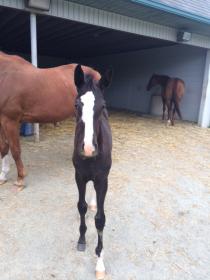I have a foal (born May 25th) that I am concerned may be a bit too fat. I have not fed him any grain to date, he is on 100% mother’s milk, grass, and hay. He is on 24/7 turnout in a 3 acre pasture. He plays a fair bit with the yearling and pony he shares the turn out with so he is getting exercise.
I would cut his dam’s grain, but she is not fat, so I don’t want to risk her getting too thin, and she is not getting much grain as it - 1 litre of Blue Seal Safe Start, 2 cups of Sunshine Plus, and 1/4 cup flax seed per day.
Should I be concerned? Or should I trust nature to know what it is doing? :winkgrin:
He is also quite tall - but not outside the normal range - approximately 12.2hh to 13hh.


 I tend to worry A LOT. :o
I tend to worry A LOT. :o

